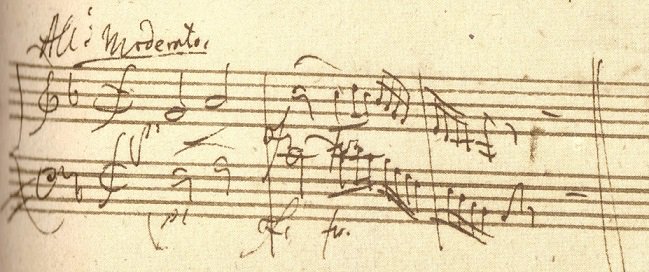String Quartet K590 (first movement)

K590 (Mozart's own thematic catalogue)
The first movement begins with a three fold statement of the main theme that blossoms on successive iterations, from a unison in all the parts, to an answering phrase that begins unison but after the first measure includes a chordal accompaniment, to a final statement that finally launches the movement on its way, fully ‘classical’ in its melody and accompaniment, with hints of free counterpoint, rhythmic and metrical clarity, and cadential drive.
[Listen to the opening of K590, 0:00-0:36]
But this is juxtaposed, in the development section, by music that can quite literally be described as empty: for at least eighteen bars virtually nothing happens, the cello (and later the first violin) articulate downbeats, the second violin and viola fill out the harmony in steady quavers, and the first violin (later the cello) provide what can only be described as a tag, a four note chromatic line that does little more than mark time in the second half of each measure – there is no melody, a motoric uniformity of rhythm and substance, and a wandering sense of harmonic direction with few downbeat root position chords: the passage is disembodied, in a way ‘absent’ by any standard reckoning of what constitutes the ‘classical’ style.
As if to show just how empty the passage is, however, it is followed by the densest stretch in the entire movement, an outburst of counterpoint that includes virtually every ‘stylistic’ element that is missing in the previous bars and that, in overabundant fashion, builds to the dominant and then to the recapitulation.
[Listen to this passage in K590 from 4:53-5:59]
This juxtaposition of emptiness and overabundance, of absence and presence, can be understood, in terms of its sensibility, as akin to souvenir. But even then, it is absence — a notion central to the idea of souvenir as both object and the evocation of feeling — that has the final word. In the end, the seeming recapturing of stability, and the repetition of the relatively unproblematic opening notwithstanding, the movement concludes with a coda that seems to suggest that recapturing ‘fullness’, as the movement apparently does, is at best chimerical. Indeed, in a sense the ending is doubly souvenir: because it recalls and prioritizes material heard considerably earlier in the movement, material that in its original context could already be characterized as empty or absent, it is itself a recollection of absence.